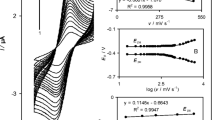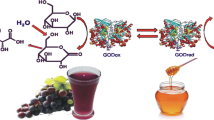Abstract
The aim of the current research is to design alcohol oxidase-based amperometric biosensors (ABSs) using hybrid metallic nanoparticles as artificial peroxidases (PO) or PO-like nanozymes (NZs). A lot of metallic PO-like NZs were synthesized and tested with respect to their ability to substitute natural PO in solution and on amperometric electrode. The most effective PO mimetics were coupled with alcohol oxidase (AOX) on graphite electrodes (GEs) and characterized. Two types of modified GEs, namely, the AOX/nAuCePt/GE and the AOX/nFePtAu/GE show the highest sensitivities to ethanol (2600 A⋅M−1⋅m−2 and 1250 A⋅M−1⋅m−2, respectively), low limits of detection (1.5 µM and 2.2 µM), broad linear ranges (5 – 100 µM and 12 – 120 µM), as well as satisfactory storage stabilities. The most sensitive bioelectrode AOX/nAuCePt/GE was used as ABS for ethanol determination in real samples. The practical feasibility of the constructed ABS was demonstrated by determination of ethanol in beverages, human blood and saliva.
Graphical Abstract



Similar content being viewed by others
References
Bollella P (2022) Enzyme-based amperometric biosensors: 60 years later … Quo Vadis? Anal Chim Acta 340517. https://doi.org/10.1016/j.aca.2022.340517
Verma D, Singh KRB, Yadav AK et al (2022) Internet of things (IoT) in nano-integrated wearable biosensor devices for healthcare applications. Biosens Bioelectron: X 11:100153. :https://doi.org/10.1016/j.biosx.2022.100153
Matzeua G, Florea L, Diamonda D (2015) Advances in wearable chemical sensor design for monitoring biological fluids. Sens Actuat B: Chem 211:403–418. https://doi.org/10.1016/j.snb.2015.01.077
Somboon T, Phatchana R, Tongpoothorn W, Sansuk S (2022) A simple and green method for determination of ethanol in liquors by the conductivity measurement of the uncatalyzed esterification reaction. LWT 154:112593. https://doi.org/10.1016/j.lwt.2021.112593
Pinheiro ACN, Ferreira VS, Lucca BG (2022) Stamping method based on 3D printing and disposable napkin: cheap production of paper analytical devices for alcohol determination in beverages aiming forensics and food control. Microchem J 180:107604. https://doi.org/10.1016/j.microc.2022.107604
Mansur AR, Oh J, Lee HS et al (2022) Determination of ethanol in foods and beverages by magnetic stirring-assisted aqueous extraction coupled with GC-FID: a validated method for halal verification. Food Chem 366:130526. https://doi.org/10.1016/j.foodchem.2021.130526
Debebe A, Redi-Abshiro M, Chandravanshi BS (2017) Non-destructive determination of ethanol levels in fermented alcoholic beverages using Fourier transform mid-infrared spectroscopy. Chem Cent J 11:27. https://doi.org/10.1186/s13065-017-0257-5
Sriariyanun M, Mutrakulcharoen P, Tepaamorndech S et al (2019) Rapid spectrophotometric method for quantitative determination of ethanol in fermentation products. Orient J Chem 35(2):744–750. https://doi.org/10.13005/ojc/350234
Duangdeewong C, Choengchan N, Wattanasin P, Teerasong S (2022) Direct determination of ethanol in alcoholic beverages based on its anti-aggregation of melamine-silver nanoparticle assembly. Talanta 250:123751. https://doi.org/10.1016/j.talanta.2022.123751
Bevanda AM, Ivankovic A, Talic S et al (2021) Determination of ethanol in wine and distilled alcoholic beverages using a smartphone as a detector. Int J Comput Theoretical Chem 9(2):43–47. https://doi.org/10.11648/j.ijctc.20210902.13
Boroujerdi R, Abdelkader A, Paul R (2022) Highly selective detection of ethanol in biological fluids and alcoholic drinks using indium ethylenediamine functionalized graphene. Sens Diagn 1:566–578. https://doi.org/10.1039/D2SD00011C
Wozniak MK, Wiergowski M, Namiesnik J, Biziuk M (2019) Biomarkers of alcohol consumption in body fluids - possibilities and limitations of application in toxicological analysis. Curr Med Chem 26(1):177–196. https://doi.org/10.2174/0929867324666171005111911
Thepchuay Y, Sonsa-ard T, Ratanawimarnwong N et al (2020) Paper-based colorimetric biosensor of blood alcohol with in-situ headspace separation of ethanol from whole blood. Anal Chim Acta 1103:115–121. https://doi.org/10.1016/j.aca.2019.12.043
Taylor L, Remeškevičius V, Saskoy L et al (2021) Determination of ethanol in micro-volumes of blood by headspace gas chromatography: statistical comparison between capillary and venous sampling sites. Med Sci Law 61(2):86–96. https://doi.org/10.1177/0025802420928632
Hernandez J, Kaun KR (2022) Alcohol, neuronal plasticity, and mitochondrial trafficking. Proc Natl Acad Sci USA 119(29):e2208744119. https://doi.org/10.1073/pnas.2208744119
Knabbe J, Protzmann J, Schneider N et al (2022) Single-dose ethanol intoxication causes acute and lasting neuronal changes in the brain. Proc Natl Acad Sci USA 119(25):e2122477119. https://doi.org/10.1073/pnas.2122477119
Alaouie AM, Alawieh MB (2020) Critical evaluation of single point measurement-based quantitative analyses in forensic breath alcohol. Forensic Sci Int 2:100101. https://doi.org/10.1016/j.fsir.2020.100101
Jones AW, Cowan JM (2020) Reflections on variability in the blood–breath ratio of ethanol and its importance when evidential breath-alcohol instruments are used in law enforcement. Forensic Sci Res 5(4):300–308. https://doi.org/10.1080/20961790.2020.1780720
Laposat M (1999) Assessment of ethanol intake current tests and new assays on the Horizon. Am J CIin Pathol 112:443–450. https://doi.org/10.1093/ajcp/112.4.443
Keim ME, Bartfield JM, Raccio-Robak N et al (1999) Accuracy of an enzymatic assay device for serum ethanol measurement. J Toxicol Clin Toxicol 37(1):75–81. https://doi.org/10.1081/clt-100102411
Bendtsen P, Hultberg L, Carlsson M, Jones AW (1999) Monitoring ethanol exposure in a clinical setting by analysis of blood, breath, saliva, and urine. Alcohol Clin Exp Res 23:1446–1451. https://doi.org/10.1111/j.1530-0277.1999.tb04665.x
Jones AW (1979) Distribution of ethanol between saliva and blood in man. Clin Exp Pharmacol Physiol 6:53–59. https://doi.org/10.1111/j.1440-1681.1979.tb00007.x
Costa NG, Antunes JC, Paleo AJ, Rocha AM (2022) A review on flexible electrochemical biosensors to monitor alcohol in sweat. Biosensors 12(4):252. https://doi.org/10.3390/bios12040252
Rao TM, Reddy PDS, Ramani P (2015) Detection of alcohol in saliva for blood alcohol concentration using alcohol saliva strip test: a forensic aid. J Dr NTR Univ Health Sci 4(1):24–29. https://doi.org/10.4103/2277-8632.153310
Mojumder S, Das T, Das S et al (2022) Y and Al co-doped ZnO-nano powder based ultrasensitive trace ethanol sensor: a potential breath analyzer for fatty liver disease and drunken driving detection. Sens Actuat B: Chem 372:132611. https://doi.org/10.1016/j.snb.2022.132611
Kock FVC, Rocha TC, Araújo GM et al (2019) Time-domain NMR: a novel analytical method to quantify adulteration of ethanol fuel with methanol. Fuel 258:116158. https://doi.org/10.1016/j.fuel.2019.116158
Avila LM, Franco dos Santos AP, Mançano de Mattos DI et al (2018) Determination of ethanol in gasoline by high-performance liquid chromatography. Fuel 212:236–239. https://doi.org/10.1016/j.fuel.2017.10.039
Oliver JD, Gaborieau M, Castignolles P (2014) Ethanol determination using pressure mobilization and free solution capillary electrophoresis by photo-oxidation assisted ultraviolet detection. J Chromatogr A 1348:150–157. https://doi.org/10.1016/j.chroma.2014.04.076
Hu X, Cao H, Dong W, Tang J (2021) Ratiometric fluorescent sensing of ethanol based on copper nanoclusters with tunable dual emission. Talanta 233:122480. https://doi.org/10.1016/j.talanta.2021.122480
Ratanawimarnwong N, Sinpun M, Chankaw P et al (2020) Simple flow system with in-line gas-diffusion unit for determination of ethanol employing hypsochromic shift of visible absorbance band of methyl orange. Talanta 206:120234. https://doi.org/10.1016/j.talanta.2019.120234
Vázquez-Guardado A, Ramirez-Flores JA, Lopez-Galmiche G et al (2019) Detection of ethanol concentration using a generic optical sensor platform. Comput Sist 23(1):27–31. https://doi.org/10.13053/CyS-23-1-3138
Li B, Chen Y, Peng A et al (2019) Improved photoelectrochemical properties of tungsten oxide by modification with plasmonic gold nanoparticles for the non-enzymatic sensing of ethanol. J Colloid Interface Sci 537:528–535. https://doi.org/10.1016/j.jcis.2018.11.061
Gayda G, Stasyuk N, Klepach H et al (2019). Promising bioanalytical approaches to wine analysis. Ch. 12, In: The Science of Beverages, Grumezescu AM, Holban AM (eds): pp. 419–458. Woodhead Publishing Inc. https://doi.org/10.1016/B978-0-12-816681-9.00012-6
Azevedo AM, Miguel D, Prazeres F et al (2005) Ethanol biosensors based on alcohol oxidase. Biosen Bioelectron 21(2):235–247. https://doi.org/10.1016/j.bios.2004.09.030
Smutok O, Ngounou B, Pavlishko H et al (2006) A reagentless bienzyme amperometric biosensor based on alcohol oxidase/peroxidase and an Os-complex modified electrodeposition paint. Sens Actuat B Chem 113:590–598. https://doi.org/10.1016/j.snb.2005.07.055
Stasyuk N, Gayda G, Zakalskiy A et al (2019) Amperometric biosensors based on oxidases and PtRu nanoparticles as artificial peroxidase. Food Chem 285:213–220. https://doi.org/10.1016/j.foodchem.2019.01.117
Smutok O, Kavetskyy T, Prokopiv T (2021) New micro/nanocomposite with peroxidase-like activity in construction of oxidases-based amperometric biosensors for ethanol and glucose analysis. Anal Chim Acta 1143:201–209. https://doi.org/10.1016/j.aca.2020.11.052
Stasyuk N, Demkiv O, Gayda G et al (2022) Highly porous 3D gold enhances sensitivity of amperometric biosensors based on oxidases and CuCe nanoparticles. Biosensors 12:472. https://doi.org/10.3390/bios12070472
Gayda G, Demkiv O, Klepach H et al (2019) Effective technologies for isolating yeast oxido-reductases of analytical importance. Ch. 5, In: Non-conventional Yeasts: from Basic Research to Application, Sibirny A. (ed.): pp. 119–151. Springer Nature Switzerland AG, Cham, Switzerland. https://doi.org/10.1007/978-3-030-21110-3
Klepach HM, Zakalskiy AE, Zakalska OM et al (2021) Alcohol oxidase from the methylotrophic yeast Ogataea polymorpha: isolation, purification, and bioanalytical application In: Barile M (ed) Flavins and Flavoproteins, E-Publishing Inc, pp. 231–248. https://doi.org/10.1007/978-1-0716-1286-6_15
Camacho C, Matías JC, Chico B et al (2007) Amperometric biosensor for hydrogen peroxide, using supramolecularly immobilized horseradish peroxidase on the β-cyclodextrin-coated gold electrode. Electroanal 19(24):2538–2542. https://doi.org/10.1002/elan.200703993
Asif M, Liu H, Aziz A et al (2017) Core-shell iron oxide-layered double hydroxide: High electrochemical sensing performance of H2O2 biomarker in live cancer cells with plasma therapeutics. Biosens Bioelectron 97:352–359. https://doi.org/10.1016/j.bios.2017.05.057
Stasyuk N, Smutok O, Demkiv O et al (2020) Synthesis, catalytic properties and application in biosensorics of nanozymes and electronanocatalysts: a review. Sensors 20(16):4509. https://doi.org/10.3390/s20164509
Stasyuk N, Demkiv O, Gayda G (2022) Reusable alcohol oxidase-nPtCu/alginate beads for highly sensitive ethanol assay in beverages. RSC Adv 12(33):21309–21317. https://doi.org/10.1039/D2RA02106D
Sivashankar S, Kumar NS, Mazumder KRN (2020) Amperometric biosensors as an analytical tool in food, dairy and fermentation industries. Int J Pharm Sci Res 65(1):68–82. https://doi.org/10.47583/ijpsrr.2020.v65i01.010
Stasyuk N, Gayda G, Demkiv O, Darmohray L, Gonchar M, Nisnevitch M (2021) Amperometric biosensors for L-arginine determination based on L-arginine oxidase and peroxidase-like nanozymes. Appl Sci 11(15):7024. https://doi.org/10.3390/app11157024.5]
Gonchar MV, Maidan MM, Pavlishko HM, Sibirny AA (2001) A new oxidase-peroxidase kit for ethanol assays in alcoholic beverages. FTB 39:37–42. http://www.ftb.com.hr/archives/103-volume-39-issue-no-1/743-a-new-oxidase-peroxidase-kit-for-ethanol-assays-in-alcoholic-beverages
Alpeeva IS, Vilkanauskyte A, Ngounou B et al (2005) Bi-enzyme alcohol biosensors based on genetically engineered alcohol oxidase and different peroxidases. Microchim Acta 152:21. https://doi.org/10.1007/s00604-005-0407-7
AOAC (2004) Definitions and calculations of horrat values from intralaboratory data. Available online: http://www.readbag.com/aoac-dietsupp6-dietary-supplement-web-site-horrat-slv. Accessed 1 Oct 2017
Acknowledgements
The authors would like to thank the Polish Academy of Sciences for financial support of exchange visits in 2022.
Funding
This research was partially supported by the National Research Foundation of Ukraine (project Nos.: 2020.02/0100 “Development of new nanozymes as catalytic elements for enzymatic kits and chemo/biosensors”), National Academy of Sciences of Ukraine: the programs: “Smart sensor devices of a new generation based on modern materials and technologies” and “Double-acting anticancer drugs to overcome the acquired resistance of malignant cells to chemotherapy” (0122U200211), Grant “New dual casein kinase 2 inhibitors and histone deacetylase for targeted tumor chemotherapy” for research laboratories/groups of young scientists in priority areas of science and technology in 2021–2022.
Author information
Authors and Affiliations
Corresponding author
Ethics declarations
Competing interests
The authors declare that they have no known competing financial interests or personal relationships that could have appeared to influence the work reported in this paper.
Additional information
Publisher's Note
Springer Nature remains neutral with regard to jurisdictional claims in published maps and institutional affiliations.
Supplementary Information
Below is the link to the electronic supplementary material.
Rights and permissions
Springer Nature or its licensor (e.g. a society or other partner) holds exclusive rights to this article under a publishing agreement with the author(s) or other rightsholder(s); author self-archiving of the accepted manuscript version of this article is solely governed by the terms of such publishing agreement and applicable law.
About this article
Cite this article
Stasyuk, N., Demkiv, O., Gayda, G. et al. Amperometric biosensors based on alcohol oxidase and peroxidase–like nanozymes for ethanol determination. Microchim Acta 189, 474 (2022). https://doi.org/10.1007/s00604-022-05568-z
Received:
Accepted:
Published:
DOI: https://doi.org/10.1007/s00604-022-05568-z




